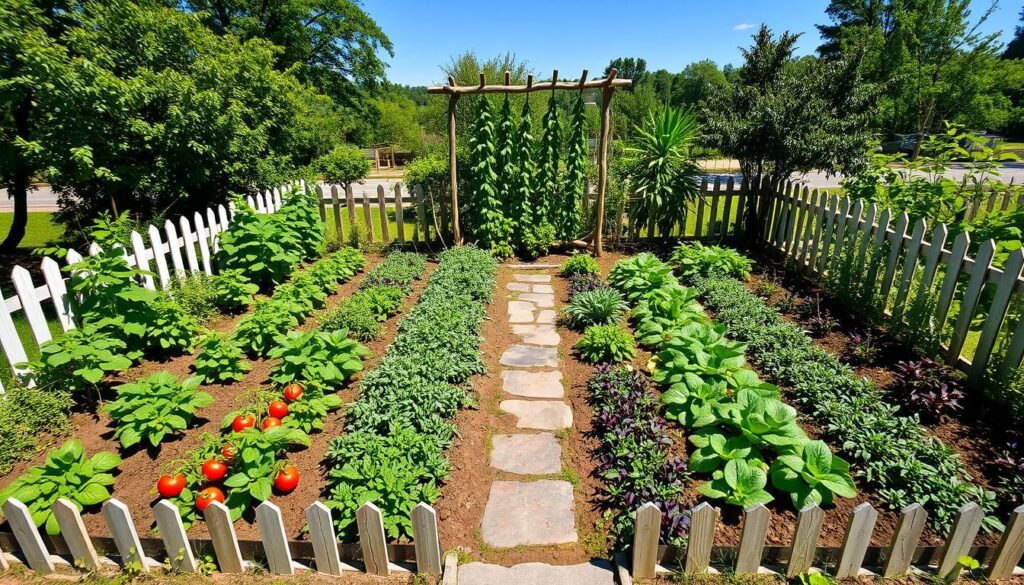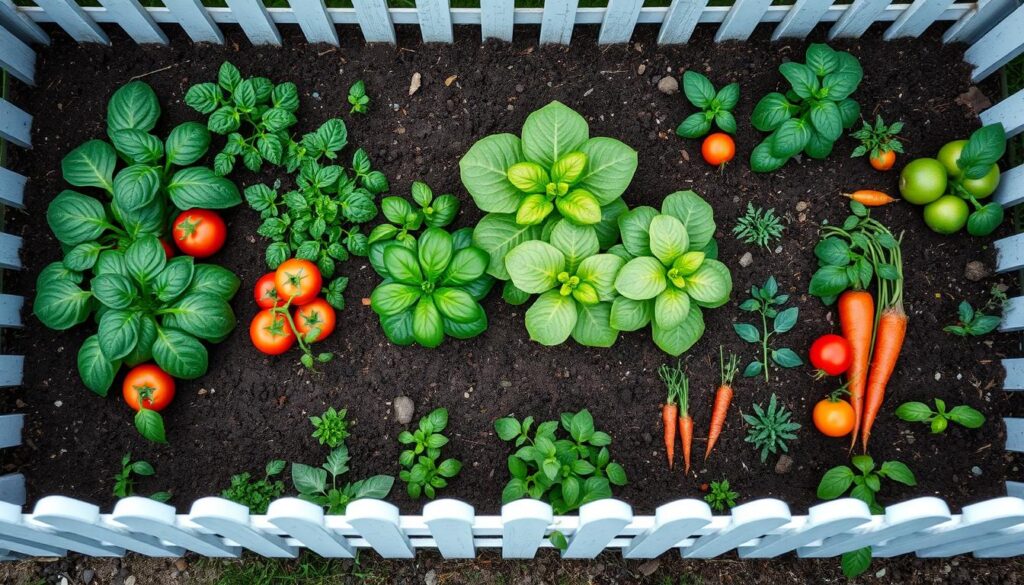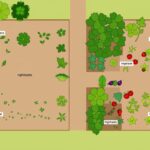How to Create a Small Vegetable Garden Layout Plan: A Beginner’s Guide
Ever dreamed of growing your own fresh veggies but thought you didn’t have enough space? Don’t worry, a small vegetable garden can be both rewarding and efficient. This guide will show you how to make the most of your space.
A small garden can be a haven of fresh produce right in your backyard. But starting can be tough. How do you make sure your small garden is full of food? The answer is in planning and layout.
Are you ready to start your small garden? Let’s dive into the secrets of creating a garden that’s both productive and space-saving. Your friends and neighbors will be jealous.
Key Takeaways
- Understand the advantages of a compact vegetable garden layout
- Learn how to strategically select the right vegetables for your small space
- Discover the power of vertical gardening techniques to maximize yield
- Explore tips for choosing the ideal garden location and size
- Gain insights on easy-to-grow vegetables perfect for beginner gardeners
Embrace a Small Garden Footprint
Gardening in a small space is great for city folks. It lets you use space well, perfect for container gardening, raised bed gardening, and community garden plots. With a small garden, you get fresh produce easily without the big work of a large garden.
Advantages of a Compact Vegetable Garden
A small garden layout is easy to keep up with. It has fewer weeds, less water, and easier plant checks, great for beginner gardeners. Plus, you can use smart gardening tricks like inter-cropping and vertical gardening to grow more in less space.
Determining the Ideal Garden Size
For urban gardening or city gardening, start with a small in-ground garden or a raised bed. A 10′ x 10′ in-ground or a 4′ x 4′ to 4′ x 8′ raised bed is good. These sizes let you grow many veggies without too much work. Remember to add paths for easy plant access. If you’re in a community garden, your plot size might be set, usually 10′ x 10′ to 20′ x 20′.
“Embracing a compact garden footprint allows you to enjoy the benefits of homegrown produce without the overwhelming task of maintaining a large plot.”
Plan Your Vegetable Selection Strategically
When planning a small vegetable garden, focus on growing what your household eats. Look at your grocery list and favorite recipes to see which vegetables you use most. Put those in your garden first, saving time and space for less used veggies.
Grow What You Eat
Think about each vegetable’s needs when planning your garden. Choose ones that grow well in a small space, like tomatoes, peppers, and leafy greens. Quick-growing veggies like radishes and bush beans can be planted often to use space well. Don’t use too much space for big, spreading plants unless you can train them to grow up.
Evaluate Vegetable Characteristics
- High-yield vegetables: Tomatoes, peppers, leafy greens
- Fast-growing crops: Radishes, bush beans
- Space-efficient plants: Compact, vertically trained varieties
Choosing the right vegetables for your small garden means a big harvest without wasting space. Pick the ones you and your family will love. Then, go for compact, high-yielding plants to fill your garden well.
Start with Seedlings for Efficient Space Utilization
Starting your vegetable garden with seedlings is smart when space is limited. Seedlings avoid the early stages of seed germination. This gives them a jump start on the growing season. It makes sure every inch of your garden works hard, without wasting space on seeds that might not grow.
Using starting vegetables from seed or using transplants has many perks for a small garden:
- Seedlings start growing earlier, so you can pick your crops sooner.
- Seed-starting tips help you grow strong seedlings ready for your garden.
- Nursery plants give you more vegetable options besides starting from seed.
- Seedlings need less space in your garden, letting you grow more plants in a small area.
Choosing seedlings makes your small vegetable garden more efficient and fruitful. It ensures a great harvest from your limited space.
“Utilizing seedlings is a game-changer for small-space vegetable gardeners – it allows you to hit the ground running and make the most of every inch of your garden.”
Maximize Vertical Gardening Techniques
Vertical gardening techniques can change the game for a space-saving garden. By training plants like cucumbers, pole beans, and some tomatoes to grow up, you save ground space. This method boosts your garden’s efficiency and adds beauty.
Vegetable Varieties Suitable for Trellising
Here are top vegetable varieties for growing vertically:
- Cucumbers
- Peas
- Pole beans
- Tomatoes
- Winter squash
DIY and Ready-Made Trellis Options
For a small garden, you can make your own DIY trellis using panels, wood frames, or old materials. Or, you can buy ready-made commercial trellises like pea supports, cucumber towers, and squash tunnels. These options help you use your garden space well and look great.
Using vertical gardening techniques lets you make the most of your small garden. You’ll get a big harvest in a small space.
Buy Locally Adapted Vegetable Varieties
When planning your small vegetable garden, picking the right plant varieties is key. Choose locally-sourced vegetable plants and regional plant varieties for better success. These plants are made for your local climate and soil.
Local farmers, gardeners, or nurseries are great places to find these plants. They offer farmers market plants and CSA seedlings that work well in your area. Big-box stores might not have plants suited for your garden.
“Locally adapted plants are more likely to thrive in your garden, requiring less maintenance and providing a higher yield of fresh, nutritious produce.”
By picking locally-sourced vegetable plants, your garden will grow well with little work. These plants know how to deal with your local weather, soil, and pests. This means your vegetables will grow big and healthy.
Check out local nurseries, farmers markets, and gardening groups for regional plant varieties. With some research and the right choices, you can make a beautiful and productive garden at home.
Small Vegetable Garden Layout Plan
Planning your small vegetable garden needs careful thought. Use intensive planting, companion planting, and succession planting to make the most of your space. Place taller plants on the north side to avoid shading smaller ones. Add pathways for easy access and include flowers or herbs to draw in beneficial insects for pest control and pollinator attraction.
Space-Saving Design Principles
Intensive planting means growing many vegetables, herbs, and flowers close together, saving space. Companion planting pairs plants that help each other out. For example, marigolds keep pests away, basil makes tomatoes taste better, and radishes help carrots grow well.
This approach increases your garden’s productivity and strength.
Companion Planting Techniques
Succession planting lets you plant different crops at various times in the same spot. This way, you can keep your garden busy all season and avoid empty spaces. Guild planting groups plants that work well together, like corn, beans, and squash. Intercropping also means growing two or more crops together in one spot, making your garden more efficient.

“Thoughtful companion planting can boost the overall productivity and resilience of your compact garden plot.”
Choose the Ideal Garden Location
Finding the right spot for your small vegetable garden is key to a great harvest. You should think about sunlight requirements, soil quality, drainage, and wind exposure when picking a garden spot.
Site Selection Criteria
Your garden needs at least 6-8 hours of direct sunlight every day. Stay away from places that are always in the shade or near buildings, trees, or other things that block the sun. Good soil that drains well is also crucial. This stops water from gathering and causing diseases in your plants. Add compost or other organic stuff to the soil to make it better.
Think about how much wind your garden gets too. Put your garden in a spot that’s not too windy. Wind can hurt your plants and stop them from growing big. Places that get a lot of wind dry out the soil and stress your plants.
Avoid places that often flood or get a lot of foot traffic. These can hurt your garden. With a good garden site evaluation, you can make the best spot for your small vegetable garden.
“The key to a thriving small vegetable garden is finding the perfect location that meets the unique needs of your plants.”
Determine the Appropriate Garden Size
Starting a small vegetable garden means choosing the right size is key. Experts suggest beginners start with a 10′ x 10′ in-ground garden or a 4′ x 4′ to 4′ x 8′ raised bed. These sizes let you grow many veggies without feeling swamped by upkeep.
If you’re using a community garden, the plot size is usually set, from 10′ x 10′ to 20′ x 20′. Make sure to include paths for easy plant access, no matter the garden size.
| Garden Type | Recommended Dimensions |
|---|---|
| In-Ground Garden | 10′ x 10′ |
| Raised Bed | 4′ x 4′ to 4′ x 8′ |
| Community Garden Plot | 10′ x 10′ to 20′ x 20′ |
Think about the small garden size, raised bed dimensions, and in-ground garden layout to make a great community garden plot. This way, you’ll have a garden that fits your needs and helps you succeed in gardening.

“The key to a successful small vegetable garden is starting with the right size and layout. Don’t be afraid to start small – you can always expand later!”
Select Easy-to-Grow Vegetables for Beginners
Starting a small beginner-friendly vegetable garden is a great idea. Choose easy-to-grow and maintain crops like lettuce, green beans, radishes, high-yield crops like tomatoes and zucchini, and fast-maturing plants such as peppers, beets, carrots, leafy greens, and peas. These plants are reliable, easy to care for, and perfect for small gardens.
Adding a few of these versatile vegetables to your garden ensures success. They help you gain gardening skills and confidence. Plus, they are packed with nutrients, making your garden a source of fresh, healthy food.
| Vegetable | Characteristics |
|---|---|
| Lettuce | Grows quickly, tolerates partial shade, easy to harvest |
| Green Beans | High-yielding, compact plants, low maintenance |
| Radishes | Fast-maturing, space-efficient, versatile in recipes |
| Tomatoes | Productive, can be grown in containers, wide variety of types |
| Zucchini | Prolific yields, bushy plants adapt well to small gardens |
Choosing these beginner-friendly vegetables leads to a thriving garden. You’ll enjoy high-yield crops and low-maintenance gardening in a small space. With the right plants and care, you’re on your way to a rewarding harvest.
Conclusion
Starting a small vegetable garden is easy for beginners. You can make the most of a small space by using smart gardening tips. This way, you can grow a lot of food in a little area.
Choosing the right vegetables and using vertical gardening are key to success. These methods help you grow more in a small garden. You can make your small garden a great source of fresh food for your family.
Even if you’re new to gardening, these tips can help you succeed. Your small garden can be a place of joy and give you fresh, tasty food. So, get creative and start your small garden project today.
FAQ
What are the advantages of a compact vegetable garden?
What are the recommended starting sizes for a small vegetable garden?
How should I select vegetables for a small garden?
Why is it beneficial to start with vegetable seedlings?
What are the benefits of incorporating vertical gardening techniques?
How can I design an efficient layout for a small vegetable garden?
What factors should I consider when selecting the location for a small vegetable garden?
What are some easy-to-grow vegetable options for beginner gardeners?
Source Links
- How to start a small vegetable garden and make the most of it – https://www.creativevegetablegardener.com/how-to-start-a-small-vegetable-garden/
- Vegetable Gardening for Beginners: The Complete Guide – https://www.almanac.com/vegetable-gardening-for-beginners
- Small Vegetable Garden Plans and Layouts – https://www.almanac.com/small-vegetable-garden-plans-and-layouts
- 10 Must-Have Blooms for Your 2025 Garden
- The Health Advantages of Gardening You Need to Know
- How to Create a Small Vegetable Garden Layout Plan: A Beginner’s Guide
- DIY Garden Projects for Small Spaces: Upcycling Ideas to Maximize Your Garden
- Watering Techniques for Small Gardens: Ensuring Your Plants Thrive
- Small Border Plants for Landscaping: Adding Beauty and Functionality to Your Garden
- Year-Round Small Space Gardening: Seasonal Planting Tips for Maximum Harvest
- Essential Tools for Small-Space Gardening: What You Really Need
- The Ultimate Guide to Container Vegetables: What to Grow in Small Spaces
- Budget-Friendly Gardening: How to Create a Thriving Garden on a Tight Budget
- How to Optimize Sunlight in Small Gardens: Tips for Better Plant Growth
- DIY Vertical Planters: Creative Ideas for Small Space Gardening
- Companion Planting for Small Vegetable Gardens: Boost Growth and Deter Pests
- Container Gardening Essentials: Choosing the Right Pots, Soil, and Plants
- Vertical Gardening Techniques: Maximizing Your Small Space with Climbers and Vines
- How to Build a Raised Bed Garden in a Small Backyard: Step-by-Step Guide
- The Best Vegetables for Small-Space Gardens: High-Yield Varieties You Need to Grow
- Smart Vegetable Garden Layouts for Small Spaces: Maximizing Your Green Thumb in Compact Areas
- 40. Best Practices for Managing a Sustainable Garden Year-Round
- Building a Wildlife Pond for Biodiversity
- Advanced Techniques in Sustainable Gardening
- How to Create a No-Till Garden
- The Mental Health Benefits of Gardening
- Using Technology to Enhance Sustainable Gardening
- Getting Certified Organic: Steps and Benefits

Leave a Reply